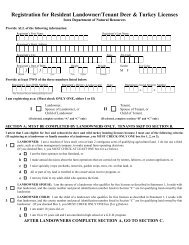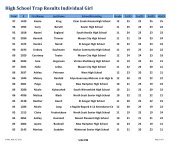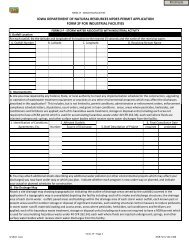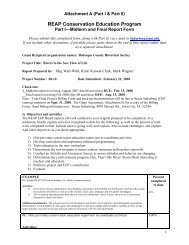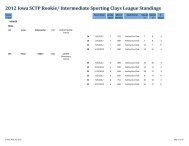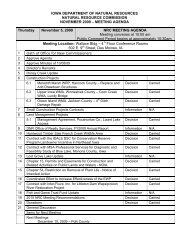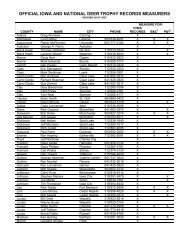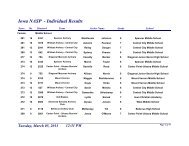3 Dams and River Ecology - Iowa Department of Natural Resources
3 Dams and River Ecology - Iowa Department of Natural Resources
3 Dams and River Ecology - Iowa Department of Natural Resources
You also want an ePaper? Increase the reach of your titles
YUMPU automatically turns print PDFs into web optimized ePapers that Google loves.
lower portions <strong>of</strong> southeastern <strong>and</strong> southern <strong>Iowa</strong> rivers.<br />
Grass carp are widespread in many <strong>Iowa</strong> rivers, <strong>and</strong> while<br />
hardly desirable are currently not viewed as having the<br />
destructive effects <strong>of</strong> bighead <strong>and</strong> silver carp. This exotic<br />
species may put additional strain on native species as its<br />
filter-feeding habits may interrupt the food chain. This can,<br />
in turn, can lead to increased pressure on threatened <strong>and</strong><br />
endangered fish <strong>and</strong> mussel species, <strong>and</strong> <strong>Iowa</strong>’s species<br />
<strong>of</strong> greatest conservation need. It has also led to economic<br />
damage to commercial fishing <strong>and</strong> sport fishing. In addition,<br />
silver carp tend to both school together <strong>and</strong> leap<br />
at disturbances, including noise <strong>of</strong> motors, splashing <strong>of</strong><br />
canoe paddles, or h<strong>and</strong>s <strong>of</strong> innertubers, resulting in fish<br />
projectiles sailing through the air. Because silver grow to<br />
several feet long, they can collide with people recreating,<br />
<strong>and</strong> can quickly ruin recreation on lakes, impoundments,<br />
<strong>and</strong> slow-moving rivers.<br />
Some dams (Figure 3-e) will be considered low priority for<br />
state funds involved in projects leading to fish passage,<br />
<strong>and</strong> may not be recommended for permits during the fish<br />
<strong>and</strong> wildlife review processes. Exceptions will be provided<br />
for projects that can improve safety without improving<br />
upstream passage for big head or silver carp <strong>and</strong> projects<br />
Asian carp barrier dams<br />
<strong>Dams</strong> in Figure 3-e are considered sufficiently tall to slow progress <strong>of</strong> Asian<br />
carp where they have not yet spread upstream to date. The image to the<br />
right illustrates how prolific <strong>and</strong> damaging silver carp can be to an impoundment.<br />
Most dams listed in this chapter are not effective barriers to persistent Asian<br />
carp, especially in light <strong>of</strong> apparent increases in frequency <strong>and</strong> severity <strong>of</strong><br />
floods in recent years. Any dam that becomes submerged will begin passing<br />
fish, <strong>and</strong> the chance <strong>of</strong> temporary or permanent damage increases during<br />
severe floods. Asian carp – especially silver carp with their ability to leap –<br />
may be better equipped to quickly take advantage <strong>of</strong> such conditions than<br />
native fish. In the case that established populations <strong>of</strong> silver <strong>and</strong> bighead<br />
carp are observed upstream <strong>of</strong> a dam, input from DNR biologists may<br />
remove a dam from the list <strong>and</strong> add a new dam to the list that is further upstream.<br />
If technologies, such as introduced parasites, introduction <strong>of</strong> sterile<br />
fish to the gene pool, or other ways to effectively limit Asian carp dominance<br />
become available in <strong>Iowa</strong>, many <strong>of</strong> the issues may be rendered moot.<br />
that have been subjected to rigorous review outlined by<br />
the US Fish <strong>and</strong> Wildlife Service <strong>and</strong>/or <strong>Iowa</strong> DNR Fisheries<br />
bureau. If both big head <strong>and</strong> silver carp are determined to<br />
be upstream <strong>of</strong> the barrier, it will no longer be subject to<br />
the same level <strong>of</strong> review.<br />
At certain dams, ecological benefits <strong>of</strong> fish passage may<br />
outweigh the negative expected effect <strong>of</strong> Asian carp.<br />
Connectivity to the Mississippi <strong>and</strong> Missouri rivers can be<br />
highly beneficial to a river’s overall diversity <strong>of</strong> species. If<br />
it can be reasonably determined that the upstream area<br />
would not provide favorable habitat for Asian carp <strong>and</strong><br />
that economic damage is likely to be minimal or low, a<br />
fish passage project could potentially be considered after<br />
rigorous scientific vetting. In any such exception, close<br />
coordination among DNR AIS staff, local fisheries management<br />
<strong>and</strong> central <strong>of</strong>fice fisheries staff, <strong>and</strong> US Fish <strong>and</strong><br />
Wildlife Service staff will be critical. Certain streams may<br />
have natural conditions that limit dominance <strong>of</strong> Asian<br />
carp, but factors are not yet well understood <strong>and</strong> cannot<br />
be considered predictive. However, the body <strong>of</strong> research<br />
appears to be growing. In the future biologists may be<br />
able to make determinations about which rivers Asian carp<br />
would negatively affect the most.<br />
37<br />
Actions<br />
1) <strong>Iowa</strong> DNR <strong>River</strong> Programs staff will coordinate with <strong>Iowa</strong><br />
DNR AIS staff to keep a current coverage <strong>of</strong> infested<br />
segments <strong>and</strong> dams that appear to block upstream<br />
progress <strong>of</strong> Asian carp.<br />
2) As dam mitigation projects are developed by communities,<br />
sovereign l<strong>and</strong>s permit applications will be routed<br />
to fisheries, AIS, <strong>and</strong> river programs staff for review.<br />
3) Hazard retr<strong>of</strong>its (see Alternative H in Chapter 4) provide<br />
a method <strong>of</strong> retr<strong>of</strong>itting dams deemed hazardous that<br />
are not wise to mitigate for fish passage due to the<br />
dam’s ability to block the spread <strong>of</strong> Asian carp. The project<br />
should be approved by AIS staff before proceeding.<br />
Zebra mussels<br />
The zebra mussel (Dreissena polymorpha) is another invasive<br />
species which can cause both harm to native ecosystems<br />
<strong>and</strong> economic damage. Issues related to dams are<br />
very different, however, due to a different type <strong>of</strong> life cycle.<br />
In lakes or impoundments, zebra mussels rapidly spread<br />
over any hard surface available, including native mussels.



